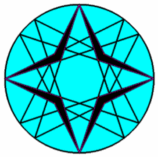5P-s-Tf6 5P-cb Conjugate
A cubic is determined by 9 points. See 9P-s-Cu1. Through 8 random points infinitely many cubics can be drawn. However according to the Cayley-Bacharach theorem they all pass through a common point, named the Cayley-Bacharach point (8P-s-P1). Since a circular cubic (7P-s-Cu1) is determined by 7 points the Cayley-Bacharach Point for this type of Cubic is determined by 6 Points. Therefore a Pentangle (5 points) and an extra random point (+1 point) will determine a Cayley-Bacharach point regarding to circular cubics, which is 5P-s-Tf6(P).
Note that the abbreviation “cb” is spelled here with lower-case letters, in contrast to the corresponding CB Conjugate 7P-s-Tf1(P), where the abbreviation “CB” is spelled with capitals.

Construction
5P-s-Tf6(P) can be constructed using the Cayley-Bacharach construction of Hart for the six points P1,P2,P3,P4,P5 and P, with a small modification. If we replace the initial conics 12345, 12346, 12356 by circles 345, 346, 356, we get the CB-point of 3,4,5,6,7,8 and the two circular points. See [64] and also [34], QFG#3403.
Properties
- 5P-s-Tf6(5P-s-Tf6(P))=P
- 5P-s-Tf6 maps each point P on 5P-s-Co1 to an infinity point, being the infinity point of P.5P-s-P4. See [34], QFG#3403.
- The 5P-s-Tf6-image of the circle through 3 vertices of the Reference Pentangle is the line through the 2 remaining vertices and vice versa. QFG#3420)
- Let P1.P2.P3.P4.P5 be a Pentangle. 5P-s-Tf6 maps lines Pi.Pj of the 5P to circles (Pk,Pl,Pm).For points P on Pi.Pj, the lines P.5P-s-Tf6(P) have a common point Qij on the circle (Pk,Pl,Pm). T = 5P-s-P4 is the common point of the 10 circles (Qij,Qjk,Qki). T and Qij is collinear with the 4th intersection of (Pk,Pl,Pm) and 5P-s-Co1. T.Pij is parallel to Xi.Xj. QFG#3420).
- For a QL with its 5 QA-Cu7-triple points (5 common finite intersection points of the 3 QL-versions of QA-Cu7) and the pivots QG-P1a,b,c we get the cubics QA-Cu7a,b,c. See [34], QFG#3412.
Estimated human page views: 247
